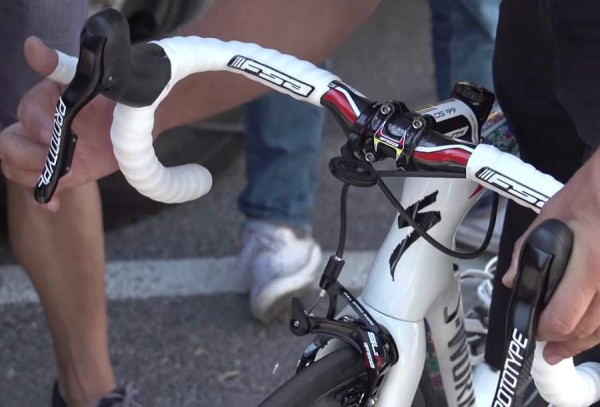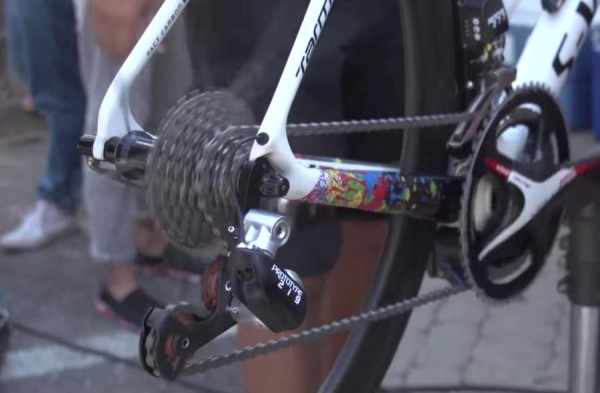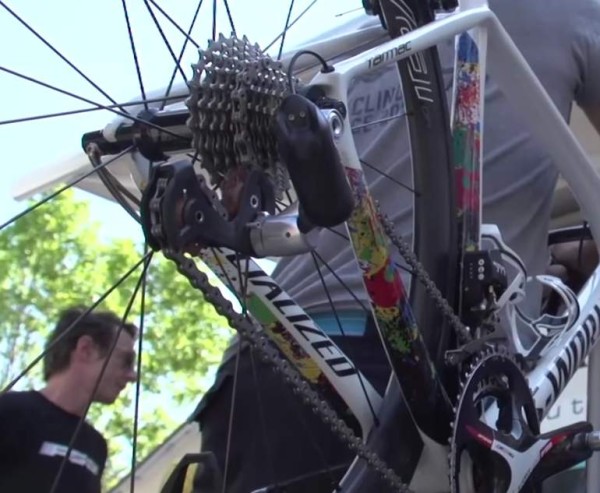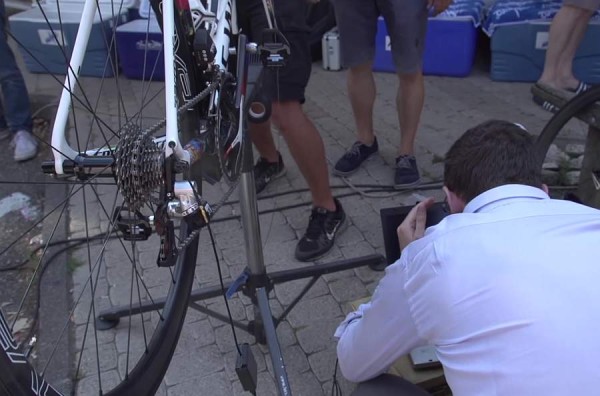Full Speed Ahead (FSA) joins the big three in cycling -Shimano, SRAM and Campagnolo- in developing an electronic derailleur and shifter group. The much rumored prototype electronic groupset is yet-to-be-named, but its finally made its first big public appearance. And what better occasion than a rest day of the 2015 Tour de France? Sharing prototype status with SRAM’s wireless electronic groupset, FSA’s potential entry into the electronic shifting market is currently gracing a few team bikes from Etixx-QuickStep, Tinkoff-Saxo, Bora-Argon 18 and Cofidis. More pics and video from GCN below…

Details of the new group are limited, with company officials refusing to provide solid details about how the system works. However, we believe the system is a semi-wireless design, with the front and rear derailleurs linked together by electronic wire, which in turn is linked to a wireless sender / receiver / control unit and battery. The control unit and battery probably reside inside the frame, and likely receive and transmit gear shift signals to the integrated brake and shift levers.
The system is clearly marked prototype, with unique numbers etched onto the front and rear derailleurs. If the range of these numerals is anything to go by, it would suggest the system has been in development for some time. The rear derailleur is quite different in appearance from everything we’ve seen from the other three manufacturers. Outer and inner limit screws seem to be in place, along with a “B” screw. However, the front derailleur is similar to the offerings from the big three, prototype or otherwise.
Huge thanks to Global Cycling Network for the video, all pics are screenshots we pulled from it.
Four LED’s – red, yellow and two in green adorn the back side of the front derailleur, with graphic indicators for a check mark, “set” and power on / off. The LED lights flickered on and off at times while on the workstand, but we believe that may be part of the system configuration process, versus normal operational mode.
The brake lever hoods are very reminiscent of Campagnolo’s design, but shifting operation appears to be like no other electronic system. Shifting appears to be handled by rocker switch neatly integrated into the rear of the lever blade – it pivots in the middle, with the top half likely for upshifts, the lower half for downshifts.
Only brake cables are seen exiting the integrated shift and brake levers, which strongly suggests wireless shifter signals are in use. We suspect a battery resides in one or both shifters, with an integrated wireless sender / receiver transmitting gear change information to both derailleurs. The positive to a semi-wireless system – remember, we believe the derailleurs are wired together, but communicate sans wires to the shifters – is one less point of failure and one less battery to worry about.
The appearance of the shift / brake levers, prototype fonts and look of the machined rear derailleur, suggest that Tiso Components had a hand in the design of this system. See our earlier article and link to Tiso’s video about their 12 speed wireless system below. Original iterations of the Tiso system were of a semi-wireless design, again suggesting a link to the current FSA design.
Clearly the system can be configured or interrogated by laptop, similar to Shimano’s eTube software, as indicated by the photo below.
Other new items for the FSA groupset are an 11-speed cassette and hollow-pin chain. FSA’s cranksets, bottom brackets, brakes, handlebars and stems have all been in production for some time. While still too early to say, FSA looks to have a complete and functioning groupset, which may receive some serious test kilometers at this year’s Tour de France!
We reached out to FSA, but they wouldn’t divulge any details other than to say its appearance at Le Tour is confirmation that they’re working on it. It was not on any team bikes during the start of the Tour, only being installed on the rest day. And there’s no confirmation the riders will use it for the remainder of the race, but at least we know it now in real world testing. We’re hoping some details will be announced at Eurobike, but they made no commitment to any launch date. More as we get it.



